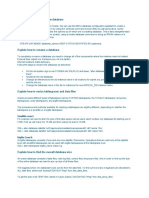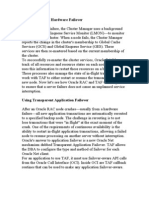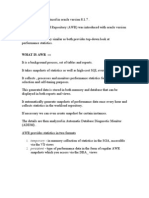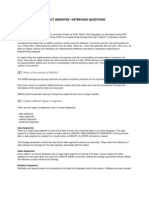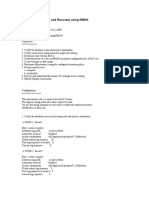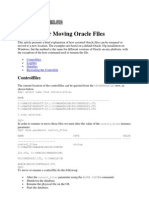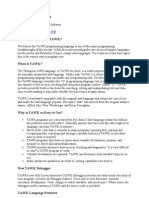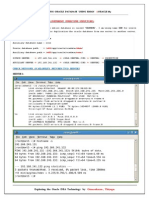0 ratings0% found this document useful (0 votes)
42 viewsMoving Files
Moving Files
Uploaded by
Kisansing GahirwarThe document discusses how to move or rename controlfiles, logfiles and datafiles in an Oracle database. It provides the steps to alter the control_files parameter, shutdown and restart the database, and use ALTER commands to update the database dictionary after renaming files on the operating system. It also describes how to rename multiple datafiles in a single tablespace.
Copyright:
© All Rights Reserved
Available Formats
Download as DOCX, PDF, TXT or read online from Scribd
Moving Files
Moving Files
Uploaded by
Kisansing Gahirwar0 ratings0% found this document useful (0 votes)
42 views3 pagesThe document discusses how to move or rename controlfiles, logfiles and datafiles in an Oracle database. It provides the steps to alter the control_files parameter, shutdown and restart the database, and use ALTER commands to update the database dictionary after renaming files on the operating system. It also describes how to rename multiple datafiles in a single tablespace.
Original Title
moving files
Copyright
© © All Rights Reserved
Available Formats
DOCX, PDF, TXT or read online from Scribd
Share this document
Did you find this document useful?
Is this content inappropriate?
The document discusses how to move or rename controlfiles, logfiles and datafiles in an Oracle database. It provides the steps to alter the control_files parameter, shutdown and restart the database, and use ALTER commands to update the database dictionary after renaming files on the operating system. It also describes how to rename multiple datafiles in a single tablespace.
Copyright:
© All Rights Reserved
Available Formats
Download as DOCX, PDF, TXT or read online from Scribd
Download as docx, pdf, or txt
0 ratings0% found this document useful (0 votes)
42 views3 pagesMoving Files
Moving Files
Uploaded by
Kisansing GahirwarThe document discusses how to move or rename controlfiles, logfiles and datafiles in an Oracle database. It provides the steps to alter the control_files parameter, shutdown and restart the database, and use ALTER commands to update the database dictionary after renaming files on the operating system. It also describes how to rename multiple datafiles in a single tablespace.
Copyright:
© All Rights Reserved
Available Formats
Download as DOCX, PDF, TXT or read online from Scribd
Download as docx, pdf, or txt
You are on page 1of 3
Moving control, log and data files
Controlfiles
1. The current location of the controlfiles can be queried from
the V$CONTROLFILE view, as shown below.
SQL> select name from v$controlfile;
2. In order to rename or move these files we must alter the value of
the control_files instance parameter.
SQL> show parameter control_files
NAME TYPE VALUE
------------------------------------ --------------------------------
------------------------------
control_files string C:\ORACLE\
ORADATA\DB10G\CONTRO
L01.CTL,
C:\ORACLE\ORADATA\DB1
0G\
CONTROL02.CTL, C:\ORACLE\OR
ADATA\
DB10G\CONTROL03.CTL
To move or rename a controlfile do the following.
Alter the control_files parameter using the ALTER SYSTEM comamnd.
Shutdown the database.
Rename the physical file on the OS.
Start the database.
Logfiles
The current location of the logfiles can be queried from the V$LOGFILE view, as shown
below.
SQL> SELECT member FROM v$logfile;
To move or rename a logfile do the following.
Shutdown the database.
Rename the physical file on the OS.
Start the database in mount mode.
Issue the ALTER DATABASE RENAME FILE command to rename the file within the
Oracle dictionary.
Open the database.
datafiles
To move or rename a data file do the following.
Shutdown the database.
Rename the physical file on the OS.
Start the database in mount mode.
Issue the ALTER DATABASE RENAME FILE command to rename the file within the
Oracle dictionary.
Open the database.
Procedure for Renaming Datafiles in a Single Tablespace
To rename datafiles in a single tablespace, complete the following steps:
1. Take the tablespace that contains the datafiles offline. The database must be
open.
For example:
ALTER TABLESPACE users OFFLINE NORMAL;
2. Rename the datafiles using the operating system.
3. Use the ALTER TABLESPACE statement with the RENAME DATAFILE clause to change the
filenames within the database.
For example, the following statement renames the
datafiles /u02/oracle/rbdb1/user1.dbf and /u02/oracle/rbdb1/user2.dbf to/u02/oracle/
rbdb1/users01.dbf and /u02/oracle/rbdb1/users02.dbf, respectively:
ALTER TABLESPACE users
RENAME DATAFILE '/u02/oracle/rbdb1/user1.dbf',
'/u02/oracle/rbdb1/user2.dbf'
TO '/u02/oracle/rbdb1/users01.dbf',
'/u02/oracle/rbdb1/users02.dbf';
Always provide complete filenames (including their paths) to properly identify the
old and new datafiles. In particular, specify the old datafile name exactly as it
appears in the DBA_DATA_FILES view of the data dictionary.
4. Back up the database. After making any structural changes to a database,
always perform an immediate and complete backup.
You might also like
- Creating Physical Standby Database With RMAN Duplicate From Active DatabaseDocument23 pagesCreating Physical Standby Database With RMAN Duplicate From Active DatabaseMangesh Abnave100% (1)
- Visual DbaseDocument77 pagesVisual DbaseOla Mi LekanNo ratings yet
- Dbase III Plus TutorialDocument24 pagesDbase III Plus Tutorialchungta9100% (2)
- User Managed Hot Backup of Oracle DatabaseDocument4 pagesUser Managed Hot Backup of Oracle DatabasedbareddyNo ratings yet
- Copy and Rename An Oracle DatabaseDocument3 pagesCopy and Rename An Oracle DatabaseSHAHID FAROOQNo ratings yet
- Oracle Database Name Change Using NIDDocument10 pagesOracle Database Name Change Using NIDknugroho1982No ratings yet
- Unit 2: Log File Management: Control FilesDocument11 pagesUnit 2: Log File Management: Control FilesDhiraj JhaNo ratings yet
- Explain How To Create A New Database: Smallfile Case IDocument6 pagesExplain How To Create A New Database: Smallfile Case ISairam YannamNo ratings yet
- Recovering After The NOLOGGING Clause Is SpecifiedDocument4 pagesRecovering After The NOLOGGING Clause Is SpecifiedPankaj RawatNo ratings yet
- Clone An Oracle Database Using A Cold BackupDocument5 pagesClone An Oracle Database Using A Cold BackupKonda Venu GopalNo ratings yet
- Create Controlfile Noresetlogs: Reuse Database "Oldlsq"Document5 pagesCreate Controlfile Noresetlogs: Reuse Database "Oldlsq"Jan ErmansNo ratings yet
- User BackupDocument4 pagesUser BackupdbareddyNo ratings yet
- Tab SpacesDocument3 pagesTab SpacessivakrishnaNo ratings yet
- Steps To Perform For Rolling Forward A Standby Database Using RMAN Incremental Backup When Datafile Is Added To Primary (Doc ID 1531031.1)Document3 pagesSteps To Perform For Rolling Forward A Standby Database Using RMAN Incremental Backup When Datafile Is Added To Primary (Doc ID 1531031.1)Phan LongNo ratings yet
- DictionayViews DescriptionDocument165 pagesDictionayViews DescriptionraajiNo ratings yet
- Recovering Standby Database When Archives Are Missing at Both Production and StandbyDocument7 pagesRecovering Standby Database When Archives Are Missing at Both Production and Standbydev4444reachmeNo ratings yet
- Select From Where Select Rpad Substr From: General InformationDocument7 pagesSelect From Where Select Rpad Substr From: General InformationSurender MarthaNo ratings yet
- DR IqDocument5 pagesDR IqNilesh ZodapeNo ratings yet
- Enhanced SQL Trace Utility From Oracle: Oracle Tips by Burleson ConsultingDocument19 pagesEnhanced SQL Trace Utility From Oracle: Oracle Tips by Burleson Consultinganjani1999No ratings yet
- Managing Undo Table SpcesDocument8 pagesManaging Undo Table SpcesVinu3012No ratings yet
- Oracle Rac TafDocument6 pagesOracle Rac TafGanji GirishNo ratings yet
- FragmentDocument14 pagesFragmentshaik.naimeNo ratings yet
- R12.2. Start and Stop Procedure Start The Database: Author - A.KishoreDocument4 pagesR12.2. Start and Stop Procedure Start The Database: Author - A.Kishoreakr15febNo ratings yet
- Less Tam6-Shrunk TablespaceDocument10 pagesLess Tam6-Shrunk TablespaceEric LiNo ratings yet
- Recovery of A Dropped TablespaceDocument5 pagesRecovery of A Dropped Tablespacetheepireddysrinath100% (1)
- Module 16b - Recovery Manager (RMAN)Document28 pagesModule 16b - Recovery Manager (RMAN)Gautam TrivediNo ratings yet
- Practicas UNDO Tema6Document42 pagesPracticas UNDO Tema6Eric VasquezNo ratings yet
- Oracle Performance TuningDocument9 pagesOracle Performance TuningMSG1803No ratings yet
- DBAI Les04 Rev1 1Document21 pagesDBAI Les04 Rev1 1ramkumarNo ratings yet
- ÷y ÷y ÷y ÷y ÷yDocument20 pages÷y ÷y ÷y ÷y ÷ydbareddyNo ratings yet
- Clone DatabaseDocument6 pagesClone DatabaseSudhanshoo SaxenaNo ratings yet
- 8 Memory ArchitectureDocument23 pages8 Memory ArchitectureBishnu Bhandari100% (1)
- Performing Database BackupsDocument20 pagesPerforming Database BackupsNett2kNo ratings yet
- Misconception of Archive Log Sequences in Data GuardDocument3 pagesMisconception of Archive Log Sequences in Data Guardnizam100% (1)
- SQL QuestionsDocument5 pagesSQL Questionsadil5821020No ratings yet
- New Features in Oracle Database 12cDocument3 pagesNew Features in Oracle Database 12csprakashyzNo ratings yet
- Steps To Migratge RAC Database From 12.1 To 12.2 - Volume 1Document18 pagesSteps To Migratge RAC Database From 12.1 To 12.2 - Volume 1zuggo848592No ratings yet
- 9i and 10 G New FeaturesDocument54 pages9i and 10 G New FeaturesabderrazzakhNo ratings yet
- Create New PDBS: - OraenvDocument4 pagesCreate New PDBS: - OraenvgmasayNo ratings yet
- Parallel Processing With Autonomous Databases in A Cluster SystemDocument24 pagesParallel Processing With Autonomous Databases in A Cluster SystemDang Huu AnhNo ratings yet
- CloneDocument13 pagesCloneagangapurNo ratings yet
- General: Select From Where Alter Select From WhereDocument3 pagesGeneral: Select From Where Alter Select From WhereSurender MarthaNo ratings yet
- Archive Log ModeDocument2 pagesArchive Log ModeMohammed AliNo ratings yet
- How To Clone A Database ManuallyDocument4 pagesHow To Clone A Database ManuallymathulelrNo ratings yet
- 02 Secnarios 12c PDFDocument10 pages02 Secnarios 12c PDFHari PrasathNo ratings yet
- Creating A Pluggable DatabaseDocument8 pagesCreating A Pluggable DatabasePatil SitaramreddyNo ratings yet
- ShrinkDocument10 pagesShrinkPavan PusuluriNo ratings yet
- Rman TutorialDocument20 pagesRman TutorialRama Krishna PasupulettiNo ratings yet
- SQLDocument4 pagesSQLAshok kumarNo ratings yet
- Data GardDocument8 pagesData GardPradeep ReddyNo ratings yet
- 2 - Oracle OCP ExamDocument16 pages2 - Oracle OCP ExamAnonymous qPo1wFyH0ENo ratings yet
- Mike Smith-DataGuard TuningDocument55 pagesMike Smith-DataGuard TuningCésar Pérez AvilezNo ratings yet
- Oracle Locks and JoinsDocument8 pagesOracle Locks and JoinsyprajuNo ratings yet
- Object Oriented - Interview Questions: What Is OOP?Document18 pagesObject Oriented - Interview Questions: What Is OOP?Sam RogerNo ratings yet
- PIA Training Centre Prime CommunicationsDocument14 pagesPIA Training Centre Prime CommunicationsArbabNo ratings yet
- Configuring HugePages For Oracle On Linux (x86-64)Document13 pagesConfiguring HugePages For Oracle On Linux (x86-64)jbNo ratings yet
- RAC Backup and Recovery Using RMANDocument7 pagesRAC Backup and Recovery Using RMANpentiumonceNo ratings yet
- LA Oracle Users Group: Succeeding With RMANDocument26 pagesLA Oracle Users Group: Succeeding With RMANSameer ShindeNo ratings yet
- Pro Oracle SQL Development: Best Practices for Writing Advanced QueriesFrom EverandPro Oracle SQL Development: Best Practices for Writing Advanced QueriesNo ratings yet
- Renaming or Moving Oracle FilesDocument5 pagesRenaming or Moving Oracle FilesEntitaetNo ratings yet
- R Prague Lesson 1Document18 pagesR Prague Lesson 1erwin1bakkerNo ratings yet
- Model SyllabusPGDocument113 pagesModel SyllabusPGRogelio R RabenaNo ratings yet
- Mauricio Guajardo - Func. IngenieriaDocument139 pagesMauricio Guajardo - Func. IngenieriaChristian Gonzalez LorcaNo ratings yet
- A. H. Deliormanli & T. Onargan Rock Mass Classification Using A Computer Program-ClassmassDocument6 pagesA. H. Deliormanli & T. Onargan Rock Mass Classification Using A Computer Program-ClassmassAzeNo ratings yet
- Primera TareaDocument7 pagesPrimera TareawilimaticoNo ratings yet
- Tuning & Diagnostic RMANDocument4 pagesTuning & Diagnostic RMANAhmed NagyNo ratings yet
- 7 Creating Query With Query Wizard and Query Designer: L L L LDocument27 pages7 Creating Query With Query Wizard and Query Designer: L L L LroselathikaNo ratings yet
- A5 SQL DB Application ArchitectureDocument24 pagesA5 SQL DB Application Architecturemikcarh58No ratings yet
- TAWK Compiler: What's New in TAWK 5.0Document4 pagesTAWK Compiler: What's New in TAWK 5.0Homero Gaspar HNo ratings yet
- Foxpro: DBMS Stand For Data Base Management System. in This System You Can Create Files, Reports, Labels EtcDocument22 pagesFoxpro: DBMS Stand For Data Base Management System. in This System You Can Create Files, Reports, Labels EtcViraj KumarNo ratings yet
- RMAN CLONING DIRECTORY STRUCTURE IS DIFFERENT - SERVER TO SERVER (10g) PDFDocument14 pagesRMAN CLONING DIRECTORY STRUCTURE IS DIFFERENT - SERVER TO SERVER (10g) PDFG.R.THIYAGU ; Oracle DBANo ratings yet
- HDM4 Road Network Export FormatDocument11 pagesHDM4 Road Network Export FormatJhl AljNo ratings yet
- Raj Kishore ResumeDocument4 pagesRaj Kishore ResumeRaj KishoreNo ratings yet
- Berikut Adalah Daftar Ekstensi FileDocument37 pagesBerikut Adalah Daftar Ekstensi Fileindah melatiNo ratings yet
- Batch Data Communication: ObjectiveDocument59 pagesBatch Data Communication: ObjectiveAshok GanasalaNo ratings yet
- Introduction To QGIS Revision3Document134 pagesIntroduction To QGIS Revision3Vilma Baltazar Aganus100% (1)
- VFP9 FocusDocument68 pagesVFP9 FocusajinomotoNo ratings yet
- Backup Recovery OracleDocument801 pagesBackup Recovery OracleshoebNo ratings yet
- Foxpro Tutorial ADocument8 pagesFoxpro Tutorial ARovel PolicarpioNo ratings yet
- Extension FileDocument35 pagesExtension FileRobby Gusnaldy SimanjuntakNo ratings yet
- Duplicate A Database Using RMAN in Oracle Database 12c Release 2Document18 pagesDuplicate A Database Using RMAN in Oracle Database 12c Release 2suhaasNo ratings yet
- Databricks - CheatsheetDocument7 pagesDatabricks - CheatsheetViniciusNo ratings yet
- AS400 CommandsDocument7 pagesAS400 CommandsDeepaPalaniappanNo ratings yet
- Delphi - Database Application Developer's Book - Delphi For Windows PDFDocument207 pagesDelphi - Database Application Developer's Book - Delphi For Windows PDFRobert BjörklundNo ratings yet
- Foxpro Tutorial BDocument9 pagesFoxpro Tutorial BRovel PolicarpioNo ratings yet
- 2.8 - Preparing Your Model For Cube Cloud ServicesDocument28 pages2.8 - Preparing Your Model For Cube Cloud ServicescitilabsNo ratings yet
- Full Transportable White Paper 12cDocument13 pagesFull Transportable White Paper 12cjamesNo ratings yet







